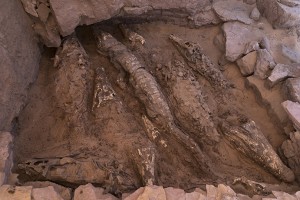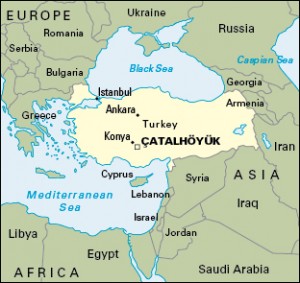In a While, (Mummified) Crocodile!
Monday, February 6th, 2023
These 2,500-year-old crocodile mummies were found at an Ancient Egyptian tomb on the Nile River.
Credit: Patri Mora Riudavets, Qubbat al-Hawā team (licensed under CC-BY 4.0)
See you later, alligator! In a while, crocodile. How long is a while? Try over two thousand years! In a recent dig in Qubbat al-Hawā, a burial site in Aswan, Egypt, archaeologists found 10 intact mummified crocodiles. We knew ancient Egyptians mummified their dead to be preserved for the afterlife, but why would they mummify crocodiles?
What does it mean to mummify? A mummy is a body that has been preserved through natural or artificial means. The most famous and elaborately prepared mummies are from Egypt. The ancient Egyptians mummified their dead because they believed the body had to be preserved for use in the afterlife. Egyptian embalmers prepared mummies by dehydrating (removing all moisture from) the body. The earliest Egyptian mummies were naturally preserved by being buried in hot, dry, desert sand. Around 4000 B.C., the Egyptians were experimenting with resin and linen wrappings to seal the body against moisture.
These 10 adult crocodiles lived nearly 2,500 years ago! They weren’t beloved pets mummified to join masters in the afterlife, they were a part of a ritual to the fertility deity Sobek. The crocodiles were found in a tomb on the west bank of the Nile River.
Sobek is portrayed with the head of a crocodile and the body of a man. Some ancient Egyptians believed he created order in the universe. He became associated with fertility. Crocodiles were very important to ancient Egyptian life. Ancient Egyptians ate crocodile meat and the fat of the crocodile was used for different medicines. Crocodiles live throughout the Nile River.
There have been other discoveries of mummified crocodiles. Most have them have been juvenile crocodiles or only pieces of remains. Egyptians mummified other animals as well. Archaezoologists, scientists who study animal remains at archeology sites, have found mummified cats, ibises, and baboons. This practice was an offering of the animal to the gods.
One of the crocodiles measured 7 feet long! The mummies had been wrapped in linen for preservation but it was eaten away by insects. There also wasn’t any resin securing the mummies, so the archeologists were able to study them in the site without having to use advanced technology like CT scans and X-rays. They think the crocodiles were mummified naturally by being buried in hot, dry sand. The researchers estimate that the crocodiles were entombed between 332 BC and 30 BC. They will radiocarbon date and study the DNA of the crocodiles to learn more. The archeologists studied the remains and concluded that there were two different species of crocodiles represented in the tomb. Some were Nile crocodiles and others were West African crocodiles. The discovery has added to our knowledge of ancient Egyptian culture, beliefs, and practices.



